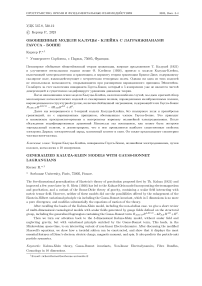Generalized Kaluza-Klein models with Gauss-Bonnet lagrangians
Автор: Kerner R.
Журнал: Пространство, время и фундаментальные взаимодействия @stfi
Рубрика: Гравитация, космология и фундаментальные поля
Статья в выпуске: 3-4 (44-45), 2023 года.
Бесплатный доступ
The five-dimensional generalization of Einstein’s theory of gravitation proposed first by Th. Kaluza (1921) and improved a few years later by O. Klein (1926) has led to the Kaluza-Klein model incorporating electromagnetism and gravitation, and a variant of the Brans-Dicke theory of gravity, containing a scalar field interacting with metric tensor field. However, neither of these models did use the possibilities offered by the enlargement of the Einstein-Hilbert variational principle via including the Gauss-Bonnet invariant, which in 5 dimensions is no more a pure divergence, and modifies substantially the equations of motion of the theory. After recalling the basics of the Kaluza-Klein model, including the non-abelian case. we give a short review of multi-dimensional cosmological models with scalar fields generated by gauge fields defined on the structural group, including the generalized lagrangian containing the Gauss-Bonnet term 𝑅𝐴𝐵𝐶𝐷𝑅𝐴𝐵𝐶𝐷-4𝑅𝐴𝐵𝑅𝐴𝐵+𝑅2. Then we turn our attention back to the 5-dimensional Kaluza-Klein model, without scalar field and neglecting gravity, but with variational principle enriched by the Gauss-Bonnet term, This leads, in the Minkowskian space-time, to an interesting variant of non-linear Electrodynamics. After discussing the modified Maxwell’s equations, we show how a toroidal soliton can be constructed, and show that it displays the most essential features of Dirac’s electron: electric charge, magnetic moment, and spin. It also predicts the particle-anti particle symmetry.
Kaluza-klein theory, gauss-bonnet invariants, nonlinear electrodynamics, fibre bundles, cosmology in 10 dimensions
Короткий адрес: https://sciup.org/142240753
IDR: 142240753 | УДК: 537.8, | DOI: 10.17238/issn2226-8812.2023.3-4.166-187
Список литературы Generalized Kaluza-Klein models with Gauss-Bonnet lagrangians
- Nordstr¨om, Gunnar. ¨Uber die M¨oglichkeit, das elektromagnetische Feld und das Gravitationsfeld zu vereinigen. Physikalische Zeitschrift 15 (1914): 504-506.
- Kaluza, Th. Zum unit¨atsproblem der physik. Sitzungsber. Preuss. Akad. Wiss. Berlin (Math. Phys.) 1921.arXiv: 1803.08616 (1921): 966-972.
- Klein, O. Quantentheorie und f¨unfdimensionale Relativit¨atstheorie. Zeitschrift f¨ur Physik 37.12 (1926): 895-906.
- Einstein, A. Zu Kaluzas Theorie des Zusammenhanges von Gravitation und Elektrizit¨at: erste- [zweite] Mitteilung. Verlag der Akademie der Wissenschaften, in Kommission bei Walter de Gruyter u. Company, 1927.
- Thiry, Y. Les ´equations de la th´eorie unitaire de Kaluza. Comptes Rendus Acad. Sci.(Paris) 226 (1948): 216.
- M. Y. Thiry (1948) Sur la r´egularit´e des champs gravitationnel et ´electromagn´etique dans les th´eories unitaires. Compt. Rend. Acad. Sci. Paris (in French). 226 pp.1881-1882.
- J. Pascual. F¨unfdimensionale kosmologie. Astronomische Nachrichten 276.5-6 (1948): 193-208.
- Scherrer, W. Uber den Einfluss des metrischen Feldes auf ein skalares Materiefeld. Helvetica Physica Acta 22.5 (1949): 537-551.
- Brans C., and Robert H. Dicke. Mach’s principle and a relativistic theory of gravitation. Physical review 124.3 (1961): 925.
- Lovelock D. The Einstein tensor and its generalizations. Journal of Mathematical Physics 12.3 (1971): 498-501.
- Witten E. Search for a realistic Kaluza-Klein theory. Nuclear Physics B 186.3 (1981): 412-428.
- Appelquist Th, Alan C. and Peter George Oliver Freund. Modern Kaluza-Klein Theories. (1987).
- Duff M. J. Kaluza-Klein theory in perspective. Proc. of the Symposium: The Oskar Klein Centenary, World Scientific, Singapore. 1994.
- Overduin J. M., and Paul S. W. Kaluza-klein gravity. Physics reports 283.5-6 (1997): 303-378.
- Wesson P. S. Five-dimensional physics: classical and quantum consequences of Kaluza-Klein cosmology. World Scientific, 2006.
- Coquereaux R. and Gilles E.F. The theory of Kaluza-Klein-Jordan-Thiry revisited. Annales de l’IHP Physique th´eorique. Vol. 52. No. 2. 1990.
- Kerner R. Geometrical background for the unified field theories: the Einstein-Cartan theory over a principal fibre bundle. Annales de l’institut Henri Poincar´e. Section A, Physique Th´eorique. Vol. 34. No. 4. 1981.
- Kerner R. Multiple fiber bundles and gauge theories of higher order. Journal of Mathematical Physics 24.2 (1983): 356-360.
- Kerner R. Electrodynamique non lin´eaire en th´eorie de Kaluza et Klein. Comptes rendus de l’Acad´emie des sciences. S´erie 2, M´ecanique, Physique, Chimie, Sciences de l’univers, Sciences de la Terre 304.12 (1987): 621-624.
- Kerner R. Non-linear electrodynamics derived from the Kaluza-Klein theory. arXiv preprint arXiv:2303.10603 (2023).
- Bruno G., and Kerner R. Cosmology in ten dimensions with the generalised gravitational Lagrangian. Classical and Quantum Gravity 5.2 (1988): 339.
- Ghosh S. G., and Sunil D. M. Cloud of strings for radiating black holes in Lovelock gravity. Physical Review D 89.8 (2014): 084027.
- Matzner R. A. and Mezzacappa A. Three-dimensional closed universes without collapse in a five dimensional Kaluza-Klein theory. Physical Review D 32.12 (1985): 3114.
- Copeland, Edmund J., and David J. Toms. Stability of self-consistent higher-dimensional cosmological solutions. Physical Review D 32.8 (1985): 1921.
- Chodos, Alan, and Steven Detweiler. Where has the fifth dimension gone?. Physical Review D 21.8 (1980): 2167.
- Sahdev, Deshdeep. Perfect-fluid higher-dimensional cosmologies. Physical Review D 30.12 (1984): 2495.
- Srivastava, S. K. Some aspects of Kaluza-Klein cosmology. Pramana 49 (1997): 323-370.
- Sorkin, Rafael D. Kaluza-klein monopole. Physical Review Letters 51.2 (1983): 87.
- Gross, David J., and Malcolm J. Perry. Magnetic monopoles in Kaluza-Klein theories. Nuclear Physics B 226.1 (1983): 29-48.
- Gervalle, Romain, and Mikhail S. Volkov. Electroweak multi-monopoles. Nuclear Physics B 987 (2023): 116112.


